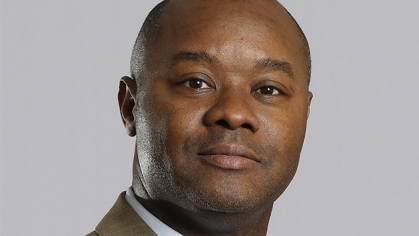Celebrating a Genre, and American History, at Institute of Jazz Studies
April is Jazz Appreciation month, but Wayne Winborne can list the many reasons jazz should be appreciated every day.
Winborne is executive director of the Institute of Jazz Studies at Rutgers-Newark, the world’s largest jazz archive and library, where thousands of LPs are housed along with artifacts such as Miles Davis’ green trumpet and Billie Holiday’s rhinestone jewelry.
For Winborne, jazz is not only beautiful music but a great unifier and window into American history. “Jazz is critically important to human beings in terms of expressing our hopes and fears. It helps us make sense of the world,” says Winborne. “It’s often talked about as a metaphor for democracy, for creating connections between and among people. It’s unique in that sense of coming out of a profoundly inhumane situation — slavery and segregation — but it’s such an expression of humanity, speaking to pain and hurt, but also better days ahead.’’
And, he points out, jazz is a source for so much American music: blues, swing, R&B, rock and hip-hop, among other genres. “It’s this river that has all these other tributaries off of it,’’ Winborne marvels.
To celebrate, the institute has scheduled a Jazz Appreciation Month concert series throughout the month at Clement’s Place, its regular showcase for local, national and international artists. Performances are also booked for May and June.
Shows were halted during the worst of the pandemic but recently resumed at 60 percent capacity, meaning Clement’s Place can now host an audience of more than 50 people. “We’re trying to ease our way back into this,’’ says Winborne, who became the institute’s director in 2015 and is an assistant professor in the Arts, Culture, and Media department of the School of Arts and Sciences.
These days, jazz is recognized as a great American art form, worthy of scholarly attention. But that wasn’t the case when the institute, the first of its kind, was founded by pioneering jazz scholar Marshall Stearns in 1952. Before attempting to find a home for his archives in academia, Stearns stored them in his Greenwich Village apartment. "He was one of the first to argue that jazz was a subject worthy of serious study. He approached a few universities in New York that turned him down before coming to Rutgers. They didn’t see the value,’’ Winborne explains.
Rutgers-Newark agreed to house Stearns’ archives in 1966, and since, both the study of jazz, and the institute’s work, have grown in stature. In addition to publishing the Journal of Jazz Studies, the institute houses more than 200,0000 recordings, 6,000 books and periodicals, and the personal possessions of many legendary artists, including instruments, clothes, sheet music, and other memorabilia.
This week, the staff was excited to receive Count Basie’s first Grammy Award, awarded to him 1958, which had been on loan to the Grammy museum in Los Angeles. Staff members are happy to share stories and trivia with visitors.
One of Winborne’s favorite items is a wig worn by Ella Fitzgerald in the 1960s. Archivist Elizabeth Surles loves an acoustic Victrola, whose volume can only be controlled by opening and closing the top cabinets. She’s also curious about one cassette in a box of tapes belonging to Ella Fitzgerald. “It says ‘mixed rock,’’’ she observes. “I wonder what’s on there, what rock she was listening to?’’
Surles won’t know the answer until the tape has been digitized. In the meantime, no one can play it because the tape is too fragile and could be damaged.
Other items may seem insignificant or even disposable but they serve to document the artists’ life and times. “There is Important ephemera: receipts, articles, telegrams, that help paint a picture of the artists as human beings and give us a look into that era,’’ said Winborne. “They give us an understanding of life in America and the social and economic conditions that the shaped artists and their music.’’
Although many jazz artists experienced racism and discrimination at home, they were beloved abroad and the U.S. government regarded them as cultural emissaries. “The State Department sponsored jazz musicians going overseas in the 1950s and 1960s as a way of exemplifying American values, even when we weren’t exemplifying them ourselves,’’ says Winborne.
While he’s an authority on the intersection of jazz and U.S. history, Winborne also knows much about Newark’s relationship to the music. Located between New York City and Philadelphia, and once home to over 20 breweries, Newark was filled with bars and speakeasies that featured live music. It was a popular tour stop for big-name jazz artists and nurtured some of the greatest, including Newarkers James Moody, Sarah Vaughn, and Wayne Shorter for whom a street will be renamed next week. “It has a deep, rich tradition in jazz,’’ notes Winborne.
He’s helping to keep that tradition alive. As LP sales have dwindled over the years, many have predicted the demise of jazz . But that doesn’t mean people aren’t listening, according to Winborne.
“Almost every city in America has a jazz festival. You even have them in Idaho and Montana,’’ he says. “Every high school has a jazz band. Many colleges offer courses and degrees in jazz performance. You can hear it on film soundtracks, on the radio, and on commercials. And it’s celebrated globally as this incredibly wonderful export.’’
And it continues to grow and evolve. “There are more trained jazz artists than ever. Some artists are merging jazz and hip-hop to make it more commercially viable and to reflect their times. I feel like the artists and their communities will figure it out,’’ Winborne says confidently. “They’ll figure out what it means to swing in 21st century context.’’
MEDIA CONTACT: Carrie Stetler, cjs281@rutgers.edu
Photo Credit: Adriana Cuervo


